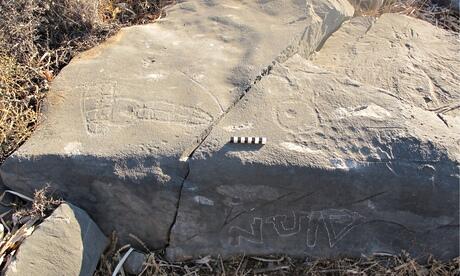
World’s oldest erotic graffiti found on the Greek island of Astypalaia
It was 2014 when prehistoric archaeologist Dr. Andreas Vlachopoulos discovered the world’s oldest erotic graffiti.
Dr. Andreas Vlachopoulos made his discovery on the island of Astypalaia, the farthest island of the Dodecanese.
Dating from the early 6th and late 5th centuries BC, one of the inscriptions depicts two phalluses carved into the flat surface of a rock in the Vathy region. Archaeologists also found the name “DION” (ΔΙΩΝ) carved into the side of the same rock.
There was another inscription found 52 meters above sea level. “Nikasitimos was riding Timiona here” (Νικασίτιμος οἶφε Τιμίονα), the inscription noted.

“They were what I would call triumphant inscriptions,” Vlachopoulos said.
The graffiti is written in a style of writing called “rustic”, first developed in the 8th century BC and common in the 6th and 5th centuries BC.
The graffiti, which expresses the erotic passion of two ancient Greeks, is well preserved because it was carved into the limestone rock.
The world's oldest erotic graffiti has been found in Greece and this is what it looks like: http://t.co/emoe73ldrQ pic.twitter.com/JNpMkIPTgD
— Digg (@digg) July 7, 2014
“By using the verb continuous [tense] in the past, it clearly says that these two men made love over a long period of time, emphasizing the sexual act in a rather unusual way in erotic artworks,” he added.
You may also like
- A 1700-year-old statue of Pan unearthed during the excavations at Polyeuktos in İstanbul
- The granary was found in the ancient city of Sebaste, founded by the first Roman emperor Augustus
- Donalar Kale Kapı Rock Tomb or Donalar Rock Tomb
- Theater emerges as works continue in ancient city of Perinthos
- Urartian King Argishti’s bronze shield revealed the name of an unknown country
- The religious center of Lycia, the ancient city of Letoon
- Who were the Luwians?
- A new study brings a fresh perspective on the Anatolian origin of the Indo-European languages
- Perhaps the oldest thermal treatment center in the world, which has been in continuous use for 2000 years -Basilica Therma Roman Bath or King’s Daughter-
- The largest synagogue of the ancient world, located in the ancient city of Sardis, is being restored











Leave a Reply